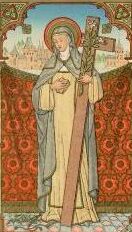Stephana de Quinzanis
Stephana de Quinzanis | |
|---|---|
 Blessed Stephana de Quinzanis | |
| Virgin and Mystic | |
| Born | 1457 Brescia, Italy |
| Died | 2 January 1530 Soncino, Italy |
| Venerated in | Roman Catholic Church |
| Beatified | 14 December 1740 by Pope Benedict XIV |
| Feast | 3 January[1] or 2 January[2] |
Blessed Stephana de Quinzanis (variant spellings include Stephanie, Stefana; also, Quinzani; 1457 — 2 January 1530) was an Italian Dominican tertiary and stigmatic.
Life
Stephana was born to pious, but poor, parents of Brescia. She earned her living working as a servant.[3] Her father, Lorenzo Quinzani, became a Dominican tertiary while Stephana was very young. On visits with him to the Dominican convent, she met the stigmatic Blessed Matthew Carrieri, who instructed her in her catechism. He told her that she was to be his spiritual heiress, a statement she did not understand for many years.[4] She began receiving visions of Dominican saints from age seven, at which point she made vows of poverty, chastity and obedience, and was given a ring, as a token of her espousal to Christ.[4] Carrieri died when Stephana was 14 years old; soon after he appeared to her in a vision, and she received the stigmata.[1]
Stephana continued on in her formation, and at age 15 became a Dominican tertiary at Soncino. her Devotion to the poor and sick led her to found a community of Third Order sisters in Soncino. She served as its first abbess. Her counsel was allegedly sought by many, including Saint Angela Merici, Blessed Augustine of Biella, and Blessed Osanna of Mantua.[1] She participated in various stages of the Passion of Jesus Christ, which was attested to by 21 witnesses in 1497 in a still extant account.[4] Sources state that although Stephana was "ugly", she had magnificent hair. Grudging herself this one beauty, she pulled it out by the roots.[5]

Stephana had a particularly intense devotion to Saint Thomas Aquinas. In fact, to overcome temptation of thought against purity, she once threw herself upon a cartload of thorns in imitation of the Doctor Angelicus. Exhausted from this penance, she prayed to Saint Thomas, and, according to legend, was girded by angels with a cord, which they tied so tightly around her waist that she cried out in pain.[4]
Though she had no formal theological training, she could discuss mystical theology at the most profound level. It is said that she could read the hearts and minds of the people around her, and had the gift of prophesy and healing. She lived in a nearly continuous fast. She accurately predicted the date of her own death.[1]
Veneration
Stephana's tomb became a pilgrimage site almost immediately. Her intercession was often felt in the convent that she had founded, where the sisters obtained both material and spiritual help through her intercession.
Her cult was popularized by Dominicans Bartholomeo of Mantua and Battista of Salò, but their Latin vitae have been lost, and only a later Italian version that combines the two texts has survived.[3] Her cultus was confirmed by Pope Benedict XIV on 14 December 1740.[1]
References
- ^ a b c d e Jones, Terry. "Stephana de Quinzanis". Patron Saints Index. Retrieved 2007-04-07.
- ^ ""Gospel Side"". Tour of the Chapel - Altar Painting. The Dominican Province of Saint Joseph. Retrieved 2007-04-07.
- ^ a b Bornstein, Daniel (2005). Dominican Penitent Women. Paulist Press. p. 251.
{{cite book}}: Check date values in:|date=(help); Unknown parameter|coauthors=ignored (|author=suggested) (help); line feed character in|coauthors=at position 4 (help) - ^ a b c d Rabenstein, Katherine (March 1999). "Blessed Stephana de Quinzanis, OP V (AC)". Saints O' the Day for January 2. Retrieved 2007-04-07.
{{cite web}}: Check date values in:|date=(help) - ^ Dunbar, Agnes (1905). A Dictionary of Saintly Women. Bell. p. 232.
{{cite book}}: Check date values in:|date=(help)
